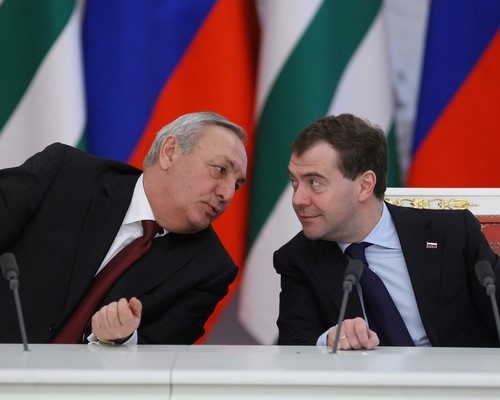
Russia Struggles to Establish a Viable Military Base in Abkhazia
Publication: Eurasia Daily Monitor Volume: 7 Issue: 33
By:

This week, the Abkhaz separatist leader, Sergei Bagapsh, arrived in Moscow to sign a number of deals with President Dmitry Medvedev on military, logistical, financial and economic cooperation. The Russian military have been officially allowed to establish a permanent “unified military base” in Abkhazia for 49 years with the possibility of prolongation. During the signing ceremony, Medvedev announced that Russia and Georgia will eventually restore “friendly relations,” but stressed that Moscow will not deal with President Mikheil Saakashvili. Medvedev described the regime in Georgia as criminal, accused it of “spilling the blood of innocent citizens” and expressed hope that Saakashvili will eventually stand trial. Bagapsh fully agreed with these views (Interfax, February 17). The signing was specially planned by the Russian authorities to occur on February 17, to commemorate the 200th anniversary of “Abkhazia voluntarily becoming part of Russia,” and now following the same course (RIA Novosti, February 17).
The Abkhazian princedom was once part of the medieval Georgian kingdom and later became a protectorate of the Ottoman (Turkish) empire. Most of the Abkhaz converted to Islam. In the early nineteenth century, Russian troops displaced the Turks from the South Caucasus and on February 17, 1810 Abkhazia became a Russian protectorate. Until 1864, Russian rule in Abkhazia was nominal, but after suppressing resistance by Chechen, Dagestani and Circassian Muslim rebels in the North Caucasus, Abkhazia was brutally annexed and its autonomy abolished. The Abkhaz rebelled in 1866 and in 1877 – 1878, were supported by Turkish troops during a war with Russia that ended in Turkish defeat in 1878. The Russian military victories were followed by the massive slaughter of the Circassian and Abkhaz population, followed by ethnic cleansing of survivors forcefully sent by sea to Turkey. The cleansed lands were resettled by Russians. That is how Sochi – the capital of the Winter Olympics in 2014 – became a Russian city. Some 90 percent of the Abkhaz population were either killed or forcibly exiled by the Russians and their loyal Georgian auxiliaries (www.newtimes.ru, February 25, 2008).
Russian oppression turned the Abkhaz nation into a tiny minority in their own land. The present Abkhaz elite that rules by suppressing the majority of the populace consisting of Armenians and Georgians, knows the history of their tribe and remembers Russia’s guilt, but the bureaucrats in Moscow seem to be ignorant, remembering only Soviet-edited history books. Today, Abkhazia is an impoverished land, the Soviet-built infrastructure in its capital Sukhumi remains in poor condition, the water polluted and the hotels empty. Abkhazia needs massive investment for basic restoration. Pre-war Abkhazia had 550,000 inhabitants in 1990, half of them ethnic Georgians, with the Abkhaz – 17 percent. The population has now declined to between 140,000 to 150,000, as a result of ethnic cleansing of the majority of Georgians and the emigration of others from the poverty-stricken region (EDM, June 26, 2008).
The Abkhaz leaders are ready to take Russian money, but do not want to see an inflow of foreign workers as residents that might dilute their nation out of existence. The infrastructural collapse in Abkhazia is a serious problem facing the Russian military as it struggles to establish a viable base.
The Russian forces in Abkhazia have been designated as “the 7th military base.” The backbone of the garrison is the 131st separate motorized rifle brigade from Maikop – the capital of the Adigey republic. In 2009, the brigade’s tank battalion was rearmed with 41 newly-built T-90 tanks, apparently outfitted with French company Thales night-vision equipment to be on a par with Georgian Israeli-modernized T-72SIM1 tanks. The 131st brigade is reinforced with heavy guns, multiple missile launchers, Tochka-U ballistic missiles, antiaircraft weapons and has some 150 armored personnel carriers (APC’s). A regiment (division) of S-300PS antiaircraft missiles has been moved to Abkhazia. Attack and transport helicopters are stationed in the old Soviet airbase Bombora, near Gudauta, together with the 7th military base headquarters. In 2009, troops were reinforced by some 1,500 Federal Security Service (FSB) Border Guards, based directly on the ceasefire line that Russia and Abkhazia claim to be the new border. A Russian naval base is being established in the coastal town of Ochamchira near the ceasefire line with Georgia. Ochamchira is a shallow water port and unable to host major Black Sea Fleet combatants permanently. Ochamchira will be the base of up to 10 smaller navy and FSB Border Guards warships. In 2009, the Russian navy began work to deepen the Ochamchira port and build land infrastructure.
The 131st brigade troops are partly near the ceasefire line, and in Bombora base. The rundown infrastructure of Abkhazia hampers the permanent deployment of sizable heavily armed forward forces. At present, Russian soldiers still largely live in tents and experience constant serious logistical problems in Abkhazia. Bad roads and lines of commutation make it a logistical nightmare to extract any forces out of Abkhazia. The 131st brigade personnel rotate on a six monthly basis in Abkhazia and then return to their old Maikop base where conditions are more habitable. But the brigade’s heavy weapons are in Abkhazia and this makes effective combat training impossible (Mikhail Barabanov, Anton Lavrov, Viacheslav Tseluiko, Tanki augusta: (The Tanks of August) Sbornik statei Moscow: Tsentr Analiza Strategii i tekhnologii Center for the Analysis of Strategies and Technologies (CAST), 2009, 144 pp., PDF from https://www.cast.ru/comments/?id=351).
The Russian strategy is for the forward deployed troops to engage the Georgians in any crisis, while massive reinforcements arrive and overrun the enemy. Abkhazian and South Ossetian formations may be used as auxiliaries. This renders the Russian positions potentially vulnerable. The Georgians are free to relocate forces from the West (facing Abkhazia) to the East to face South Ossetia, while Russian forward positioned troops with their weapons are bogged down in each enclave. The precarious situation may partially explain Russian paranoia – the constant accusations of “Georgians preparing a new aggression” (Kommersant, December 25, 2009). It would seem prudent from the point of view of Russian military and political planners not to sit and wait for the opposition to choose a time and weather of their convenience to possibly attack, but to take the initiative, mobilize air, land and sea forces in advance at a time of their choice. Russian forces could break out of the seclusion of their present enclaves to dominate again the entire former Soviet South Caucasus, also reducing the reliance on Abkhazian and Ossetian whims.




